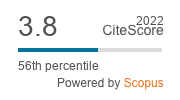An Approach to Minimising Estimated Pincushion Camera Distortions
Abstract
Minimizing camera distortion has been a focus of recent photorealism researches. Of the several types of camera distortions, researchers concentrated on the radial distortion being the most severe part of the total lens aberrations. Often, polynomial approximations by introducing distortion-specific parameters into the camera model have been methods of evaluating distortions. Of the two types of radial distortions, barrel, is the most discussed probably because of its dominance in cheap wide-angle lenses. In this paper, an approach to estimating and minimizing pincushion distortion by using fundamental surface area properties of the distorted image is proposed. This paper is significant as it reveals the importance of the topic and its implications on the camera. Demonstrations using four camera lenses show the robustness of this technique under different focal lengths conditions. The reliability of the approach is justified by comparing the results with the physical observations using (two tailed) t-test statistic.
Full Text:
PDFReferences
Carlos Ricolfe-Viala and Antonio-Jose Sanchez-Salmeron. Lens distortion models evaluation. Applied Optics. 2010; 49(30): 5914-5928.
Ronald T. Azuma. A Survey of Augmented Reality. In Presence: Teleoperators and Virtual Environments. 1997; 6(4): 355-385.
Zhang Z. A Flexible New Technique for Camera Calibration. Microsoft Research. Microsoft Corporation. December, 1998.
Pajdla T, Werner T, Hlavac V. Correcting Radial Lens Distortion without knowledge of 3D Structure. Technical Report: TR97-138, FEL CVUT. Karlovo namesti 13. Praha, Czech Republic.
Perš J, ovaˇciˇcS. K. Nonparametric, Model-Based Radial Lens Distortion Correction Using Tilted Camera Assumption. Proceedings of the Computer Vision Winter Workshop. Bad Aussee, Austria. 2002: 286–295
Jiang L. Precision grating for measuring microscope lens distortions. International Journal of Metrol. Qual. Eng. 2010; 1(2): 83-88
Sobolewski VC. Using moiré patterns to determine the distortion of graphics displays and graphics input devices. Proceedings of the IEEE. 1970; 58(4): 567-576.
Tsai RY. A versatile camera calibration technique for high- accuracy 3D machine vision metrology using off-the-shelf TV cameras and lenses. IEEE Journal of Robotics and Automation. 1987; RA-3(4): 323-334.
Zhengyou Z. The epipolar geometry between two images with lens distortion. In proceedings of International Conference on Pattern Recognition. 1996: 407-411.
Abdullah J. & Martinez. Camera Self – Calibration for ARToolkit. 2002.
Dron L. Dynamic Camera Self Calibration from Controlled Motion Sequences. In proceedings of IEEE Conference on Computer Vision and Pattern Recognition. 1993: 501-506.
More J. The levenberg-marquardt algorithm, implementation and theory. In G. A.Watson, editor, Numerical Analysis, Lecture Notes in Mathematics 630. Springer-Verlag. 1977.
Levenberg K. A Method for the Solution of Certain Non-linear Problems in Least Squares. Quarterly of Applied Mathematics. 1944; 2(2): 164–168.
Lampton M. Damping-Undamping Strategies for the Levenberg-Marquardt Nonlinear Least-Squares Method. Computers in Physics Journal. 1997; 11(1): 110–115.
Folorunso OA, Mohd S, Ikotun AM. Augmented Reality Prototype for Visualising Large Sensors’ Datasets. TELKOMNIKA Indonesian Journal of Electrical Engineering. 2011; 9(1): 161-170
Mohammed Munither Abdul Majeed. Edge Detection in Image Processing. TELKOMNIKA Indonesian Journal of Electrical Engineering. 2004; 2(2): 107-111.
DOI: http://doi.org/10.12928/telkomnika.v9i3.748
Refbacks
- There are currently no refbacks.

This work is licensed under a Creative Commons Attribution-ShareAlike 4.0 International License.
TELKOMNIKA Telecommunication, Computing, Electronics and Control
ISSN: 1693-6930, e-ISSN: 2302-9293
Universitas Ahmad Dahlan, 4th Campus
Jl. Ringroad Selatan, Kragilan, Tamanan, Banguntapan, Bantul, Yogyakarta, Indonesia 55191
Phone: +62 (274) 563515, 511830, 379418, 371120
Fax: +62 274 564604

